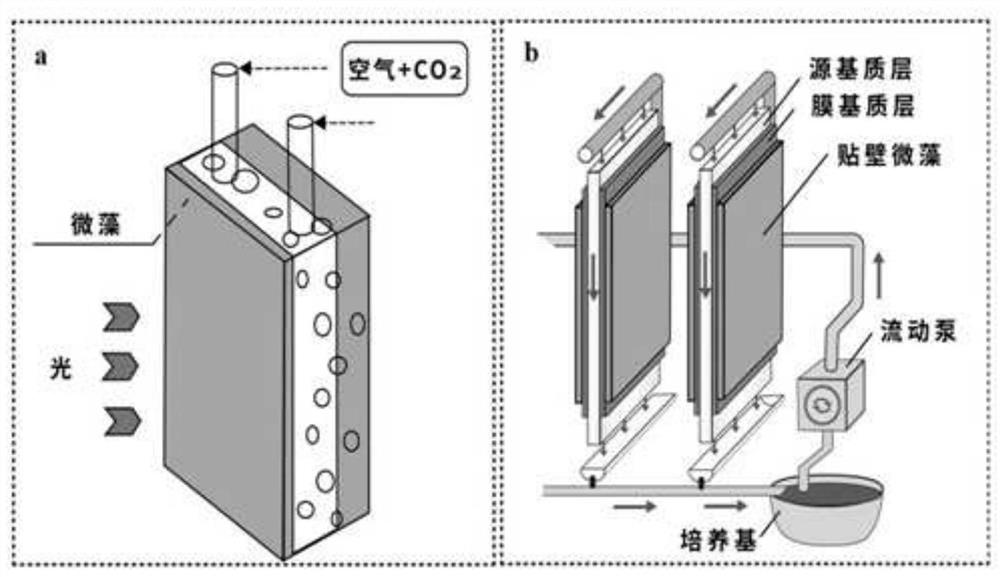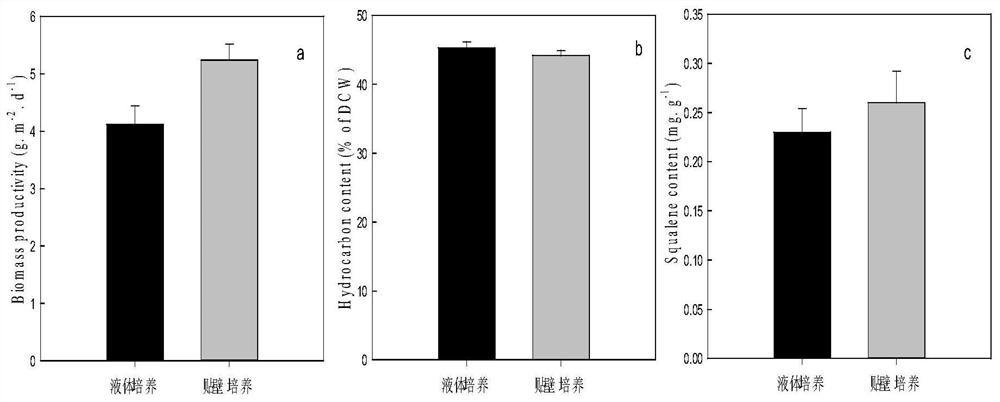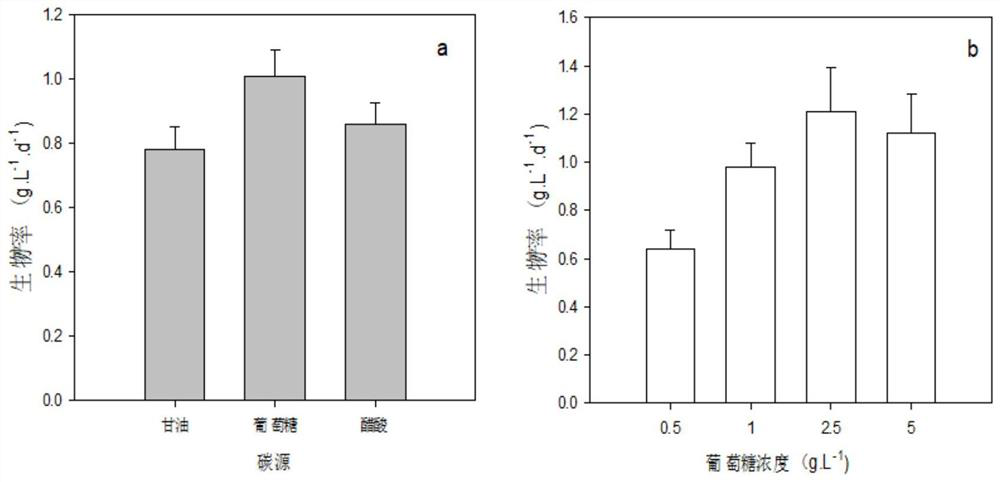Method for preparing squalene by utilizing heterotrophic biological membrane adherent autotrophic culture of grape algae
A technology of grape algae and biofilm, applied in the direction of microorganism-based methods, biochemical equipment and methods, microorganisms, etc., can solve the slow growth of algae cells, the research on the production of grape algae squalene has not received much attention, and the limitation of grape algae Problems such as the medical application of squalene to achieve the effects of promoting synthesis, protecting the marine ecological environment, and increasing production
- Summary
- Abstract
- Description
- Claims
- Application Information
AI Technical Summary
Problems solved by technology
Method used
Image
Examples
Embodiment 1
[0020] Embodiment 1: the comparison of botrytis liquid culture and biofilm adherent culture squalene production
[0021] Put Botrytis (B.braunii) in BG 11 medium, 1% CO 2 Concentration (volume ratio), light intensity 3000lux, liquid culture and adherent culture were carried out under the condition of temperature 25 ℃ respectively ( figure 1 a and b). BG 11 (g.L -1 ) The composition ratio of the medium is as follows: potassium nitrate 1.5, magnesium sulfate heptahydrate 0.075, dipotassium hydrogen phosphate trihydrate 0.04, anhydrous calcium chloride 0.027, sodium carbonate 0.02, citric acid 0.006, ferric ammonium citrate 0.006, ethylene di Sodium ferric amine tetraacetate 0.001, A5 solution 5mL, pH7.5.
[0022] The photobioreactor (PBR) used for the B.braunii liquid suspension culture experiment consists of a plate reactor (length 50cm, width 20cm, thickness 1cm, volume 1L) with an illumination area of 0.1m 2 ; Adhesive culture is that botrytis is separated from the medi...
Embodiment 2
[0024] Example 2: Effects of Different Carbon Sources and Their Concentrations on the Growth of Botrytis under Heterotrophic Conditions
[0025] Under the same light intensity (3000lux) and the same conditions as in Example 1, botrytis was respectively cultivated at an added concentration of 2.0g.L -1 In the medium with different organic carbon, the organic carbon sources were glycerol, glucose and acetic acid. Culture results such as image 3 as shown in a. The results show that Botrytis grows best in the medium where the organic carbon source is glucose, and the biological yield is 1.01g.L -1 .d -1 .
[0026] Under the condition that the organic carbon source is determined to be glucose, set different carbon source concentrations of 0.5, 1.0, 2.5, 5.0g.L -1 To cultivate. The results showed that botrytis in the concentration of glucose 2.5g.L -1 Under the best growth conditions, the biological yield is 1.21g.L -1 .d -1 .
Embodiment 3
[0027] Embodiment 3: adjust the N concentration to improve the yield of squalene produced by botrytis under autotrophic conditions
[0028] Botrytis was adherently cultured in BG 11 medium with different initial N concentrations under the same conditions as in Example 1 for 7 days. The initial N concentration was set to normal BG 11 (1.5g.L -1 ), 1 / 2N (0.75g.L -1 ), 1 / 4N (0.375g.L -1 ), 1 / 8N (0.1875g.L -1 ), 0N.
[0029] The result is as Figure 4 As shown, Botrytis has little difference under the conditions of normal N concentration of BG 11, 1 / 2N, 1 / 4N, and the biological yield is 5.24, 5.08, 4.86g.m -2 .d -1 , while the growth of algae cells was inhibited under the conditions of N concentration of 1 / 8N and 0N, and the biological output was 3.32 and 2.83g.m -2 .d -1 .
[0030] As for the content of squalene, the content of squalene under low N conditions was significantly increased, and the content of squalene under different N concentration conditions (normal BG11,...
PUM
| Property | Measurement | Unit |
|---|---|---|
| Aperture | aaaaa | aaaaa |
Abstract
Description
Claims
Application Information
 Login to View More
Login to View More - R&D
- Intellectual Property
- Life Sciences
- Materials
- Tech Scout
- Unparalleled Data Quality
- Higher Quality Content
- 60% Fewer Hallucinations
Browse by: Latest US Patents, China's latest patents, Technical Efficacy Thesaurus, Application Domain, Technology Topic, Popular Technical Reports.
© 2025 PatSnap. All rights reserved.Legal|Privacy policy|Modern Slavery Act Transparency Statement|Sitemap|About US| Contact US: help@patsnap.com



